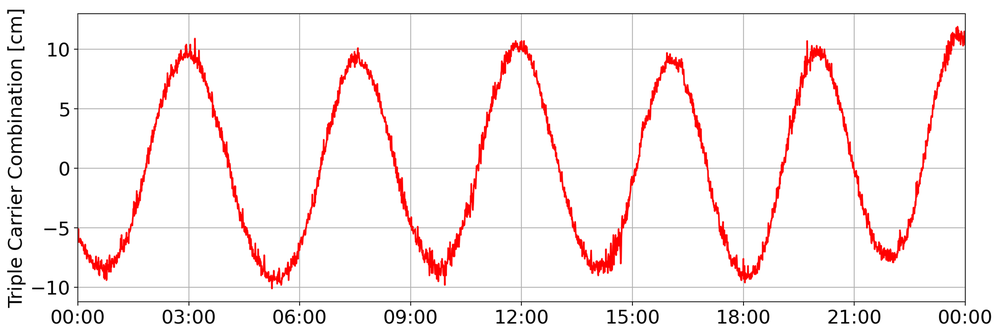GNSS signal analysis
The 30 m antenna at the Weilheim ground station and the Cooperative Network for GNSS Observation (CONGO) are primarily used to analyze GNSS signals. This includes analyzing new types of signals from new generations of satellites as well as monitoring signals for changes and anomalies.
GLONASS K1+
K1+ is the first generation of GLONASS satellites that also transmits a Code Division Multiple Access (CDMA) signal on L2. GLONASS M+ and K1 satellites only transmit CDMA signals in the L3 band, the latest K2 generation on L1, L2 and L3. The consistency of different signals can be assessed using an ionosphere- and geometry-free linear combination. The influence of the ionosphere and geometry is eliminated by a suitable combination of three signals. Remaining effects are primarily measurement noise and frequency-dependent signals. The latter show clear periodic variations in the case of the first K1+ satellite, see Fig. 1. Both the period and the amplitude are time-varying. The periods fluctuate between 15 minutes and several days, the amplitude reaches peak values of 20 cm. The cause of these variations is not known, possible explanations are crosstalk between different oscillators or malfunctions in the time distribution system or the clocks themselves.

Flex Power

GPS satellites have the ability to redistribute the transmit power between the various signal components. This so-called flex power can be observed with GNSS receivers as well as with the dish antenna in Weilheim and has been used in various global and regional forms since 2017. Figure 2 shows the influence of flex power on the power spectral density measured in Weilheim. Here, the M-code signal was deactivated, causing the two secondary maxima at 1566 and 1585 MHz to disappear. Thus, the power of the P-code signal with a center frequency of 1575.42 MHz was increased by approx. 6 dB.
Further Reading
Thoelert, S., Steigenberger, P., & Montenbruck, O. (2024). GLONASS-K2 signal analysis. GPS Solutions, 28(3). https://doi.org/10.1007/s10291-024-01681-z
Esenbuğa, Ö. G., Hauschild, A., & Steigenberger, P. (2023). Recent flex power changes. GPS Solutions, 27(3). https://doi.org/10.1007/s10291-023-01415-7
Thoelert, S., Steigenberger, P., Montenbruck, O., & Meurer, M. (2019). Signal analysis of the first GPS III satellite. GPS Solutions, 23(4), 92. https://doi.org/10.1007/s10291-019-0882-7
Steigenberger, P., Thölert, S., & Montenbruck, O. (2019). Flex power on GPS Block IIR-M and IIF. GPS Solutions, 23(1). https://doi.org/10.1007/s10291-018-0797-8
Thoelert, S., Hauschild, A., Steigenberger, P., Langley, R. B., & Antreich, F. (2018). GPS IIR-M L1 Transmit Power Redistribution: Analysis of GNSS Receiver and High-Gain Antenna Data. Navigation, 65(3), 423–430. https://doi.org/10.1002/navi.250
